Vereenigde Nederlandsche Scheepvaart (VNS)

 Dutch shipping optimism was high in 1920 and resulted in the formation of the United Netherlands Navigation Company (VNS) on 30th April 1920 with a capital of 200 million guilders by eight partners, the Royal Netherlands Steamship Company (KNSM), Nederland Stoomvaart Maats, Rotterdam Lloyd, Royal Packet Navigation Company (KPM), Java China Japan Line (JCJL), Holland America Line, S.M. ‘De Maas’ (Van Ommeren), and Van Nievelt, Goudriaan & Company. VNS took over the following routes:-
Dutch shipping optimism was high in 1920 and resulted in the formation of the United Netherlands Navigation Company (VNS) on 30th April 1920 with a capital of 200 million guilders by eight partners, the Royal Netherlands Steamship Company (KNSM), Nederland Stoomvaart Maats, Rotterdam Lloyd, Royal Packet Navigation Company (KPM), Java China Japan Line (JCJL), Holland America Line, S.M. ‘De Maas’ (Van Ommeren), and Van Nievelt, Goudriaan & Company. VNS took over the following routes:-
- Holland-British India Line from Holland America Line and Van Ommeren
- Holland-Australia Line from Rotterdam Lloyd
- Holland-East Asia Line from Nederland S.M. and Van Nievelt, Goudriaan
- Holland-West Africa Line in conjunction with Holland Steamship Company and Royal Holland Lloyd (KHL)
- Holland-East Africa Line
In 1924, VNS combined the Holland-East Africa Line, which had served Dutch interests of the Uasin Gishu plateau area of Kenya from the turn of the century, and the Holland-South Africa Line, the latter founded in 1919 with financial support from the Dutch Government for five years. The first sailing to South Africa was made by the chartered Dorp in December 1919, and then six vessels were purchased over the next two years. These were Jagersfontein and Rietfontein, both of Japanese origin, the Clyde built Randfontein, Bloemfontein the former Dakar built in 1899 of Elder, Dempster, and two new ships, the turbine propelled Klipfontein of 8,710 dwt and the triple expansion steam powered Springfontein of 9,500 dwt. This sextet had accommodation for up to thirty four passengers. The Holland-South Africa Line was liquidated in 1932, and the VNS then took over the fleet of five vessels with ‘fontein’ suffixes to their name and its goodwill for the Holland-Africa Line. Thus, by 1932, the routes served by VNS were to West Africa, South Africa, East Africa, the Far East, Australia and India.
KNSM remained as a member of VNS until 1969, but importantly had transferred most of the vessels that made up the first fleet of VNS in 1921. KNSM had obtained permission from the British Government to form the David Steamship Co. Ltd. of London, and acquired seventeen German prize ships allocated to the U.K. as war reparations from Germany. In 1921, when the export of ships was allowed by the British Government, fourteen of these ships went to VNS. These were in the size range from 7,500 dwt to 10,000 dwt and had been built between 1911 and 1917, and were given the VNS names of Aagtekerk, Abbekerk, Almkerk, Arendskerk, Bovenkerk, Hoogkerk, Koudekerk, Meerkerk, Meliskerk, Nijkerk, Oldekerk, Oostkerk, Ouderkerk and Rijperkerk.
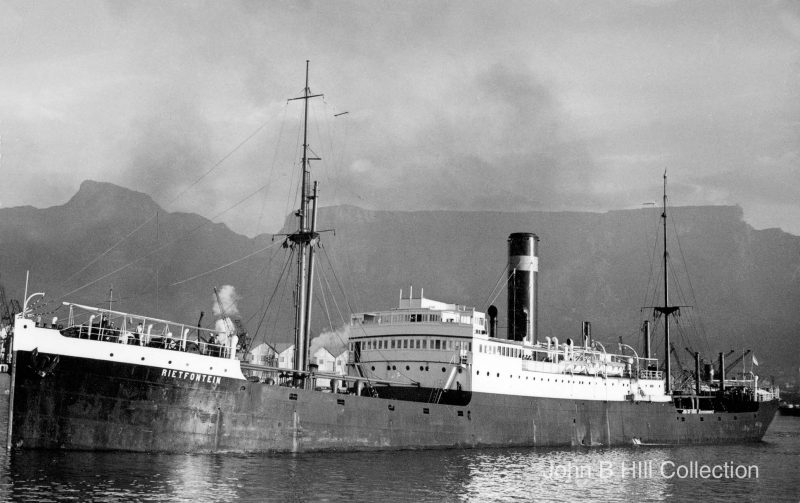
By 1932, by purchases from Dutch shipping companies, the fleet had grown to 31 deep sea cargo vessels and four coasters, distributed over the routes as follows:-
HOLLAND AFRICA LINE
Jagersfontein, Klipfontein, Randfontein, Rietfontein, Springfontein Grijpskerk, Heemskerk, Ijselkerk, Meliskerk, Nias, Nieuwkerk, Nijkerk, Waalkerk, Westerkerk on two ‘Round Africa’ routes, from Hamburg, Amsterdam, Rotterdam and Antwerp to Cape Town, Port Elizabeth, East London, Durban, Lourenco Marques, Beira and return via East African ports and the Suez Canal, or from Hamburg, Amsterdam and Antwerp to Port Said, Port Sudan, Mombasa, Tanga, Zanzibar, Dar-es-Salaam, Mozambique and Beira returning via South African ports.
HOLLAND BRITISH INDIA LINE
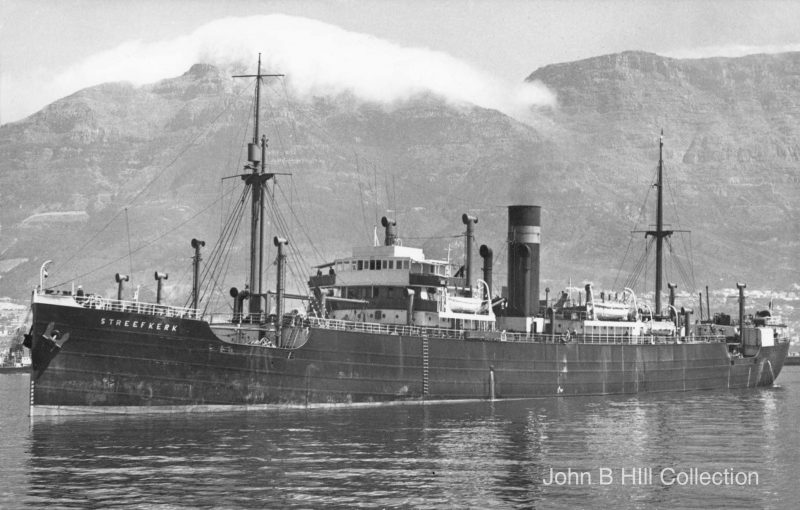
Bovenkerk, Giekerk, Hoogkerk, Meerkerk, Ridderkerk, Schiekerk, Streefkerk on the routes from Bremen, Hamburg, Rotterdam, Antwerp to Port Said, Kathiawar, Colombo, Madras, and Calcutta returning via the same route, or from Bremen, Hamburg, Rotterdam, Antwerp to Port Said, Karachi and Bombay.
HOLLAND EAST ASIA LINE
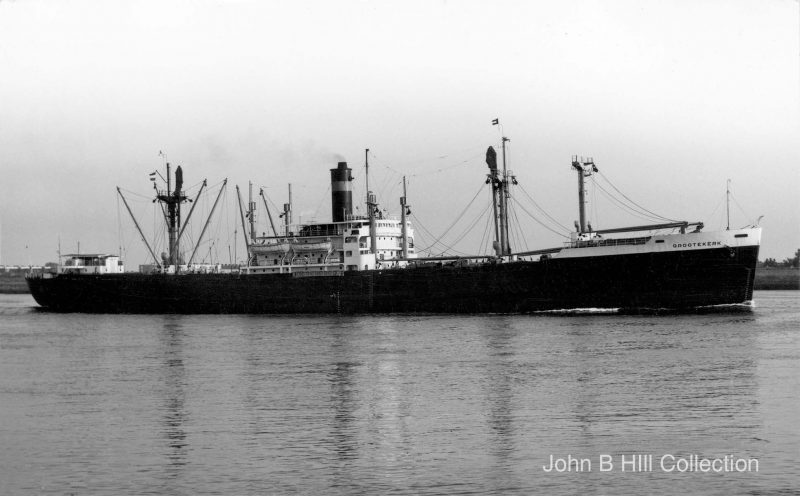
Gaasterkerk, Grootekerk, Oldekerk, Oostkerk, Oudekerk, Serooskerk, Zuiderkerk on the route from Hamburg, Amsterdam, Rotterdam, Antwerp to Genoa, Port Said, Colombo, Singapore, Manila, Hong Kong, Shanghai, Dairen and Japanese ports, returning via the same route but calling also at Jaffa and Marseille.
HOLLAND WEST AFRICA LINE
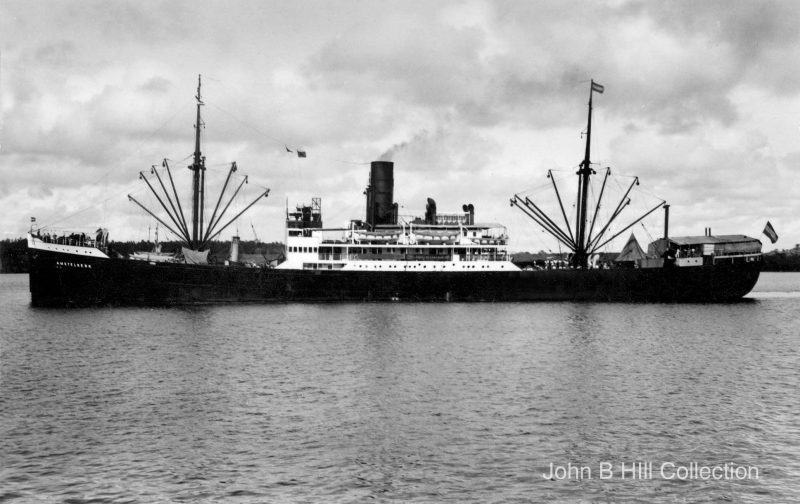
Amstelkerk and Maaskerk of 5,955 dwt completed in 1929 with accommodation for 168 passengers and powered by double reduction steam turbines to give a service speed of 12.5 knots. They served on the route from Hamburg, Amsterdam, Bordeaux to Las Palmas de Gran Canaria, Dakar, Freetown, Monrovia, Port Bouet, Takoradi, Winneba, Accra, Lome, Cotonou, Lagos, Port Harcourt, Calabar, Duala, Kribi, Santa Isabel returning via the same route and calling at Le Havre instead of Bordeaux.
HOLLAND AUSTRALIA LINE
Arendskerk on the route from Bremen, Hamburg, Rotterdam to Fremantle, Adelaide, Melbourne, Sydney (NSW), and Brisbane and returning via the same route but also calling at Le Verdun and Dunkirk.
The biggest cargo vessels in the fleet were the turbine powered Gaasterkerk and Grootekerk of 10,090 dwt, completed in 1922/23 for Holland America Line as Gaasterdijk and Grootedijk, and purchased in 1931 by VNS and renamed. They were lengthened in 1932 to dimensions of 508 feet overall, beam of 58.2 feet and depth of 37.2, with a fo’c’stle of length fifty feet on the shelter deck. They were powered by three steam turbines manufactured at Clydebank by John Brown & Co. Ltd. to give service speeds of 14.5 knots.
VNS PASSENGER LINERS
BLOEMFONTEIN and JAGERSFONTEIN (2)
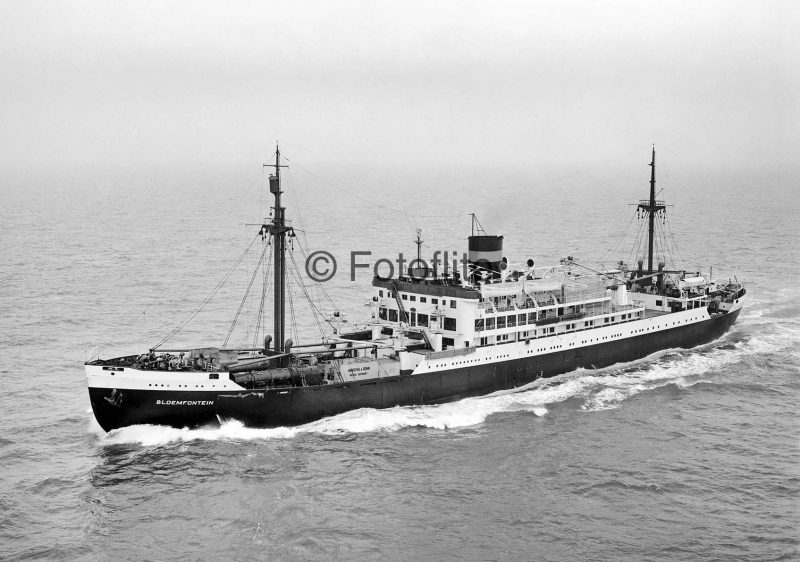
Two twin screw passenger liners of 10,100 grt were completed by the Nederland yard at Amsterdam in 1934. Bloemfontein, the name meaning ‘flowering mountain’, and Jagersfontein named for a mountain with an important De Beers diamond mine eighty miles south of Kimberley near Fauresmith and the Riet river, were distinctive in appearance with pronounced Maierform bows. They had overall lengths of 489 feet, moulded beam of 63 feet, depth of 30.5 feet and draft of 30.9 feet when fully loaded with 10,565 tonnes of cargo. Six electric deck cranes and derricks on two tall masts provided easier cargo handling for general and refrigerated cargo on the monthly sailings from Dutch ports to Walvis Bay, Cape Town, Port Elizabeth and Durban. Two sets of powerful six cylinder two cycle direct acting Stork-Hesselman diesel engines of 8,400 bhp manufactured by the builder with bunker capacity of 1,790 tonnes provided service speeds of 16.5 knots. The Master, navigating and engineering officers were Dutch, with the stewards and the remainder of the crew of 88 from the Dutch colonies.
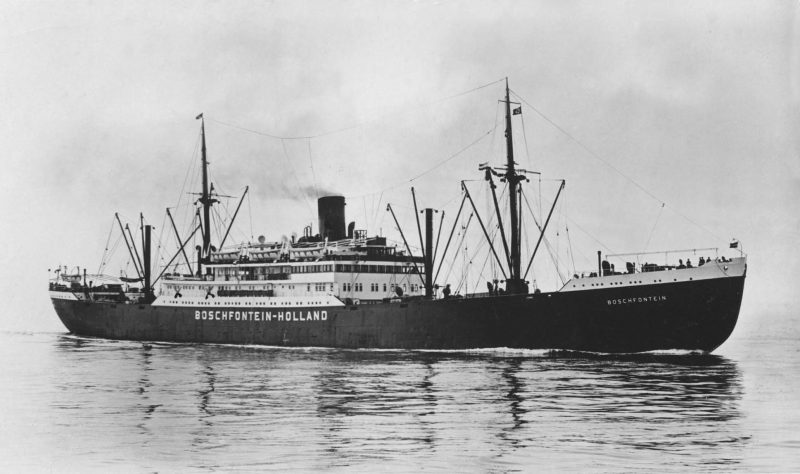
A new pronounced Maierform bow had first been fitted on the cargo ship Nieuwkerk of 8,740 dwt, built at the end of 1928 by the Van Smit yard at Rotterdam, when she was lengthened in early 1934 by 31.4 feet by the De Schelde yard at Flushing to improve her seakeeping qualities, and increase her service speed with new diesel engines under her new name of Boschfontein. The much older Meerkerk, the former Nienburg and Tamora built in 1916, was also given a Maierform bow when she was lengthened in 1934 and her passenger capacity was increased. Bloemfontein was launched on 16th June 1934 by radio signal by Mrs. J.B.M. Hertzog, wife of the Prime Minister of South Africa, from her home city of Pretoria 6,500 miles away. She was completed in October 1934 and sailed on her maiden voyage to South African ports, Beira and Lourenco Marques from Hamburg and Amsterdam on 27th October 1934. Jagersfontein (2) was launched on 21st July 1934 and completed in time to sail for South African ports before Christmas Day of 1934. They had accommodation for 81 passengers in First Class and 34 passengers in Second Class, the snag for those of the latter class was that their cabins were located at the stern above the thrashing noise of the propellers. This poor design was perpetuated in the next trio of passenger liners under construction in 1939, and was only rectified in the last of the ‘fontein’ passenger liners, Randfontein of 1958, when the Tourist Class accommodation was moved to the ‘midships superstructure.
KLIPFONTEIN (2), ORANJEFONTEIN and JAGERSFONTEIN (3)
The next trio of ‘fontein’ passenger liners was Klipfontein (2), Oranjefontein and Rietfontein, the latter completed as Jagersfontein (3) in 1950. They were ordered in 1937 as liners of 10,800 grt, with two orders going to the P. Smit Junior yard in Rotterdam and the third to the Schichau yard at Danzig. They had dimensions of overall length 520 feet, moulded beam of 63 feet, depth of 30.3 feet, with four electric cranes and a dozen derricks (Klipfontein and Oranjefontein), including a heavy lift of 45 tonnes capacity, on two tall masts to handle 10,600 tonnes of general and refrigerated cargo. Twin B. & W. double acting oil engines of 11,800 bhp by the builder gave a service speed of 17 knots although a maximum speed of 20.5 knots was attained on trials. Klipfontein and Oranjefontein had accommodation for 106 First Class passengers and sixty in Tourist Class with a crew of 120. They had four passenger decks with the First Class Dining Room, Smoking Room and Lounge as well as the swimming pool on Promenade Deck. The First Class cabins were twin bedded and together with a few single cabins had private facilities. Tourist Class aft had two, four or six berth cabins but suffered from noise and oily smells. The trio did not have Maierform bows or hull construction, and only Klipfontein was completed before the start of hostilities in September 1939 and made a few peacetime voyages to South Africa.
The passenger liner Klipfontein was used by the Allies after the fall of Holland in May 1940, and became a transport and troopship for the U.S. War Shipping Administration on 23rd February 1942. She was used by the U.S. Army on a time charter of four years as USAT Klipfontein, one voyage being the transport of the U.S. Army X Army Corps from San Francisco on 14th July 1944 to Oro Bay (New Guinea) and Philippines ports. Oranjefontein, her sister, was launched on 21st March 1940 and upon completion was taken to Germany and renamed Pionier. She was requisitioned in 1941 by the German Navy to be used as a target ship for U-boats and the Luftwaffe. She struck a mine east of Rixhoft on 30th April 1944 and was taken to Kiel, and was then used in the Baltic for rescue of German nationals from Poland in the first months of 1945. She was taken as a prize at Kiel in May 1945, and was then refitted on the Tyne and was ready for repatriation duties by 12th September 1945, and arrived in Sydney (NSW) in mid November. She also carried Dutch citizens home from the Dutch East Indies before resuming her South African service in April 1946.

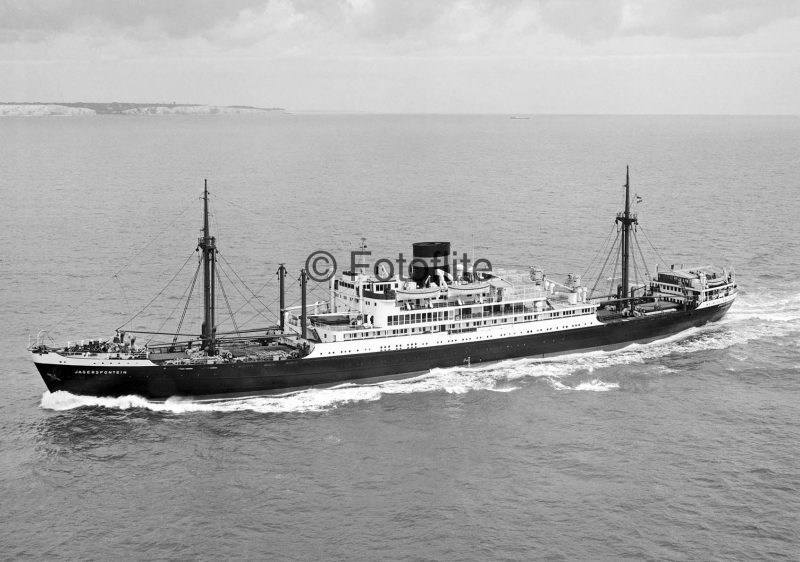
The third sister passenger liner Rietfontein was laid down at a shipyard in Danzig in 1939. The reason for this was that she was built in a barter deal with part payment by tobacco crops from Sumatra. She had her name changed to Elandsfontein, but at the end of the war, when a Dutch mission was sent to retrieve the vessel, they found her in a terrible state and half submerged in the Vistula river after being shelled by artillery. She had been claimed as a prize by Russia, but after considerable diplomatic negotiation, she was released to Holland and towed to the famous De Schelde yard at Flushing for completion in 1950 as Jagersfontein (3).
WORLD WAR II LOSSES
A total of eleven VNS ships became war losses from a large fleet of 26 vessels plus a fleet of coasters on the East African coastal service. The war losses included the handsome Maeirform bowed passenger liner Jagersfontein of 1934:-
- Arendskerk torpedoed and sunk on 15th January 1940 by U44 100 miles off Quessant on a voyage from Rotterdam and Antwerp to Durban with mail and general cargo including corrugated sheets, nails, brass tubes and similar items, crew saved.
- Heemskerk bombed on 20th January 1941 to west of Foynes by German planes, abandoned and later sunk next day by U105 while on a voyage from Rangoon to Liverpool with rice, bran cake, pig iron, lead and general cargo, 48 saved but 8 lost.
- Grootekerk torpedoed and sunk on 18th February 1941 by U123 to the west of Ireland.
- Almkerk torpedoed and sunk on 16th March 1941 by U106 to south of the Cape Verde Islands on a voyage from Fremantle to Avonmouth with wheat, crew of 63 and 3 passengers saved.
- Aagekerk bombed on 14th June 1942 in convoy WM11 near Tobruk on a voyage from Alexandria to Malta with Government stores, grounded off Mingar Garab as a total wreck, 39 passengers and 7 crew lost.
- Jagersfontein torpedoed and sunk by U107 on 26th June 1942 around 500 miles from Bermuda on a voyage from Galveston to Liverpool with general cargo including lead, copper, resin, and carbon black, all saved from crew of 55, 12 gunners and 98 passengers.
- Abbekerk torpedoed and sunk on 24th August 1942 by U604 to west of Ireland on a voyage from Trinidad to Liverpool with mail, sugar and general cargo, two crew lost.
- Zuiderkerk torpedoed on 28th August 1942 by U556 in convoy SL119 to west of Portugal on a voyage from Karachi and Freetown to the Clyde with wool, cotton, oilseed, hides and general cargo, sunk next day by British patrol ship Leith, crew saved.
- Gaasterkerk torpedoed and sunk by U68 in the Indian Ocean on 8th October 1942 on a voyage from Alexandria and Aden to Cape Town and New York, crew of 64 saved.
- Serooskerk torpedoed and sunk by U155 on 28th November 1942 to the north west of the Azores, all crew lost.
In addition, Springfontein caught fire in her cargo at Freetown in 1941 and burnt out on the Sierra Leone river, becoming a total loss and was abandoned. Meerkerk was lost after the end of the war in 1946 when she struck a mine off Westkapelle. A dozen ships were managed for the Dutch Government during the war, including Vermeer, a standard ‘Empire’ type launched in 1941 as Empire Raleigh.
POST-WAR REBUILDING
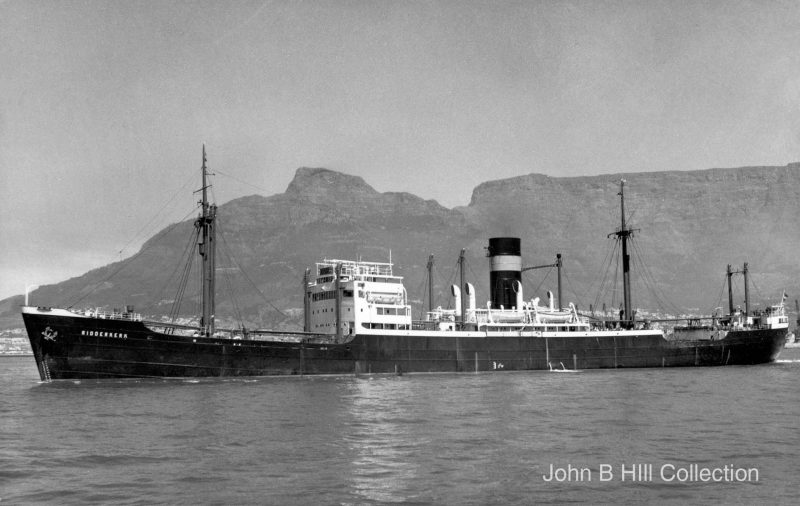
These war losses were replaced by over twenty standard war built cargo ships, including ten ‘Liberty’ ships, eight ‘Victory’ ships, three ‘C3’ types, as well as the former Hansa Line vessel Hohenfels, built in 1938 and managed during the war by VNS as Van Ruysdael after she was scuttled at Bandar Shahpur on 25th August 1941. The latter vessel was then purchased in 1947 and renamed Ridderkerk. The fast cargo-liner Empire Trust had been completed on the Clyde in 1941 and was transferred to the Dutch Government a year later as Rembrandt, and was transferred to VNS in 1947 and renamed Rijnkerk, along with other German war prizes.
The passenger liner Jagersfontein (3) underwent four years of rebuilding at the Flushing yard of De Schelde before entering service in March 1950. She differed from her two earlier sisters in that her ‘B’ deck was extended forward and she was given sixteen cargo derricks, including a heavy lift of 45 tonnes capacity, and two electric cranes for cargo handling. She was fitted with twin nine cylinder Sulzer diesel engines of 11,800 bhp to give a service speed of 17 knots with a maximum speed on trials of twenty knots. She had accommodation for 144 First Class passengers and 60 in Tourist Class with a crew of 110. The First Class public rooms included the air conditioned Dining Room, Main Lounge, Verandah Lounge with a view forward over the bow, cocktail bar and a swimming pool. She sailed on her maiden voyage from Hamburg on 22nd March 1950 for a Round Africa voyage to South and East Africa returning via the Mediterranean. Although this route was repeated at times, she normally only reached Durban, Beira and Lourenco Marques before returning westwards via Cape Town.
A large fleet of five hold engines ‘midships cargo-liners was then built by Dutch and German yards for VNS during the years between 1949 and 1962. They had three holds in front of the bridge and two aft, with derricks on two masts and three sets of posts and a smaller centreline mast at number one hold. Thirty two ships were built to this design with the later examples having raked bows e.g. Schiekerk, Serooskerk, Servaaskerk, Simonskerk, Sinoutskerk, Sloterkerk, Spaarnekerk, Steenkerk and Streefkerk of 1960/62. The VNS fleet had been rebuilt to 52 ships by 1960, and included the new and memorable passenger liner Randfontein of 1958.

The Holland West Africa Line service was operated by a number of smaller cargo-liners, all with a suffix ‘kust’ to their names, some owned by the Holland Steamship Company with services to West Africa since 1920. On 1st January 1959, the big Nederland Stoomboot Maats acquired all of the share capital of Holland Steamship Company. The latter company had Angolakust, Ghanakust, Guineekust, Camerounkust, Gabonkust, Liberiakust and Togokust sailing to West Africa, while VNS ships included Beninkust, Peperkust and Ivoorkust of 4,858 dwt completed at Emden in 1953 as four hold cargo ships, and they were joined in 1959 by Dahomeykust of 6,025 dwt, and sisters Congokust (ex Van Linschoten of KPM) and Senegalkust (ex Van Spilbergen of KPM) of 7,398 dwt. The West African service was operated to ports ranging from Dakar to all those in West Africa and in the Congo and in Angola until the late 1970s in conjunction with British, French and Scandinavian shipping companies. Beninkust, Peperkust and Ivoorkust were sold off in 1967/68, Congokust and Senegalkust were sold off in 1971, and Dahomeykust was sold in 1972.
RANDFONTEIN

Randfontein was the best ship of the sextet of big Holland-Africa Line passenger liners that served South Africa for nearly forty years. She was the second ship of that name in the VNS fleet, the first being the cargo ship Staur completed at Greenock in 1920 and renamed for the Holland-South Africa Line as Randfontein in 1921, surviving the war to have her passenger accommodation removed and renamed as Randkerk in 1947. Randfontein (2) floated out from the graving dock of the Wilton Fijenoord yard at Schiedam on 28th June 1958. She was named by Mrs. Geldenhuys, wife of the South African Ambassador to The Hague, on 24th November 1958 and sailed on her maiden voyage to South African ports, Beira and Lourenco Marques on the same day. She had five passenger decks for 123 First Class and 166 Tourist Class passengers, all located in the ‘midships superstructure. The First Class cabins were located on ‘A’ deck and all had private facilities. The Tourist Class passengers were located on ‘B’ deck in two, four or six berth cabins, all having shared facilities. ‘B’ deck was extended forward over number three hold and aft over numbers four, five and six holds. She had six holds with numbers three and four holds trunked through the accommodation. Fourteen cargo derricks plus a heavy lift derrick were positioned on two tall masts and two sets of posts with the addition of two electric cranes to serve numbers four and five holds.
The Dining Rooms, Lounges and bars of both sets of accommodation were excellent with good decoration comparable to much bigger liners. The great benefit of air conditioning in all public rooms and cabins eased the travellers through the tropics. There were two tiled swimming pools for the two classes of passenger, and the entertainment was of a high standard in the evening. She had eight lifeboats, and unusually her radar scanner was mounted on the crosstree of the forward mast for better reception of radar echoes. She measured 13,694 grt on dimensions of length 585 feet, moulded beam of 70 feet and draft of 29.5 feet. She was twin screw and powered by twin M.A.N. diesels constructed by the builder of 15,400 bhp to give a service speed of 18 knots. She was fitted with deep tanks and large refrigerated capacity for the homeward trades of vegetable oils and fruit.
Randfontein had been ordered to replace Klipfontein, which had been lost on 8th January 1953 after striking a submerged set of rocks that triggered an explosion in the forward bunker spaces off Cape Barra near Inhambane (Mozambique). The older liner sank bow first within one hour in calm seas, with all passengers soon rescued from the lifeboats by Bloemfontein Castle of Union-Castle Line. Capt. J.A. Ferguson and his Senior Officers of the British liner all received gifts from Holland-Africa Line in gratitude for the prompt rescue of all passengers. The older Bloemfontein of 1934 was substituted on the express service to South Africa until the arrival of Randfontein. The trio of liners, Randfontein, Jagersfontein (2) and Oranjefontein, then maintained a monthly service to South Africa from the end of 1958 until Oranjefontein arrived for breaking up at Bilbao in August 1967, and Jagersfontein (2) was sold in November 1967 to Embajada Compania Naviera S.A. of Greece. The latter liner made one outward voyage to Kaohsiung with scrap under the name of Devon and arrived at Kaohsiung on 23rd December 1967 for breaking up.

VNS FINALE
The big Dutch shipping companies of Nederland Line and Rotterdam Lloyd formed closer links with Royal Interocean Lines (KJCPL), and on 24th October 1969 a complete fusion and merger was announced into the Nederland Scheepvaart Unie (Netherlands Shipping Union or NSU), a holding company with interests that ranged from liner services to tankers, bulkers and ro-ros. The shares in VNS were taken over by this NSU holding company, and to simplify matters outside shareholders transferred their shares to one of the NSU partners. Nederland Line acquired those of KNSM, Rotterdam Lloyd those of Holland America Line, and Royal Interocean Lines (KJCPL) the Van Ommeren shares of VNS. The NSU was based at Katwijk and Nedlloyd (formed on 1st July 1970) took over this building as their new headquarters. The VNS white houseflag with an orange part to the mast and a blue part to the fly was lost in this merger, as a new Nedlloyd houseflag appeared in 1970. The black funnel colours with a central orange band of VNS were however retained for the new Nedlloyd combine.
Randfontein was transferred to Royal Interocean Lines in 1971 and renamed Nieuw Holland and given a white hull during a refit at Hong Kong. A single white painted electric crane replaced one of the forward pair of posts. She became a one class ship with accommodation for 390 passengers on a Hong Kong to Australia route. She arrived at Brisbane on 21st January 1972 on her maiden voyage, at Sydney (NSW) three days later and Melbourne on 7th February 1972. She made only one cruise from Singapore to Australia and New Zealand in 1973, and was then transferred to a new service from Adelaide to Risdon (Tasmania), Sydney (NSW), Port Moresby, Bali, Surabaya, Jakarta, Singapore and Penang with return to Singapore and Australia. This lasted for only four voyages, and after only three years service, Nieuw Holland sailed from Sydney (NSW) for the last time on 22nd October 1974 for Singapore. She was laid up at Hong Kong and sold to Cosco of China for a China to East Africa service as Yu Hua. After a few years, she was transferred to a Shanghai to Hong Kong service renamed as Hai Xing, serving for ten years until broken up at Alang in 1996 as Herbert. She had a very useful career of 38 years, including serving with the elegant Dutch liners Tjiwangi and Tjiluwah built in 1950 and known as the ‘Dutch white yachts’ on the Singapore to Australia route.
On the merger in Nedlloyd in 1970, the VNS cargo-liners were engaged on two routes, one to South Africa and one to the Far East. They sailed from Amsterdam and Rotterdam to Las Palmas, Tenerife, Cape Town, Port Elizabeth, East London and Durban, or to Mediterranean ports, Suez, Persian Gulf, India, Malaya, Hong Kong, China, Japan and Australia. Some 35 VNS cargo-liners were transferred into Nedlloyd in 1970, with 15 of these gaining a ‘Nedlloyd’ suffix to their names in 1977/78. The last quartet of cargo-liners built for VNS in 1967 as Wissekerk, Waalekerk, Westerkerk, and Willemskerk were included in the renaming. They had six holds, five in front of the bridge and one aft, served by eight electric cranes and a heavy lift derrick on the foremast. Willemskerk of this group was the last of the VNS cargo-liners to go for scrapping in 1990 at Chittagong as Arrow Queen after a career of 23 years.
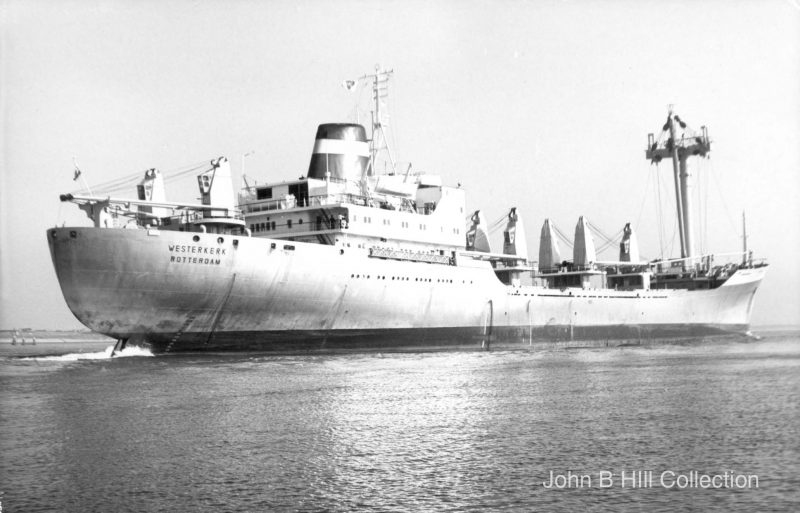
A steam turbine powered cellular container ship of 1,500 TEU capacity had been ordered in Holland for VNS in 1968 but had been transferred to Nedlloyd before completion in March 1971. She was named Abel Tasman after the great Dutch explorer who discovered Australia, and was renamed Nedlloyd Tasman in 1978, but had a short career of only fifteen years on the Australian service before being sent for scrapping in 1986. She was of 27,614 grt with a long fo’c’stle and with some of her containers carried in and on a hold behind the superstructure. She served in conjunction with six British ‘Bay’ container ships, two German and one French container ship to Australia.
POSTSCRIPT
The large fleet of VNS passenger and cargo ships with ‘fontein’ suffixes for the South African route and ‘kerk’ suffixes for the Far Eastern and other routes were in existence for fifty years from 1920 until merged into the Nedlloyd combine in 1970. They had black hulls with red or pink boot topping, brown masts, and white superstructures, and their central orange funnel bands were seen for many more years on a dark blue funnel until lost after the takeover of P. & O. Nedlloyd by Maersk Line of Denmark in May 2005. The passenger liners Randfontein (2), Jagersfontein (3) and Oranjefontein are remembered by myself with affection at Southampton on their regular calls en route from Holland to South and East Africa for Holland Africa Line.

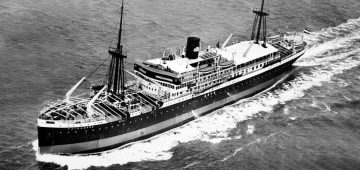



Comments
Sorry, comments are closed for this item